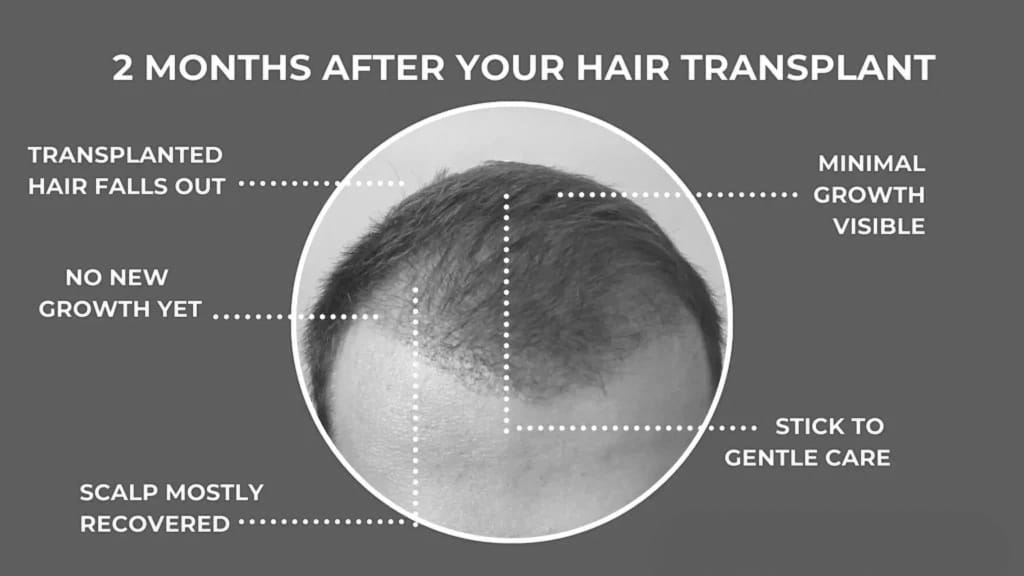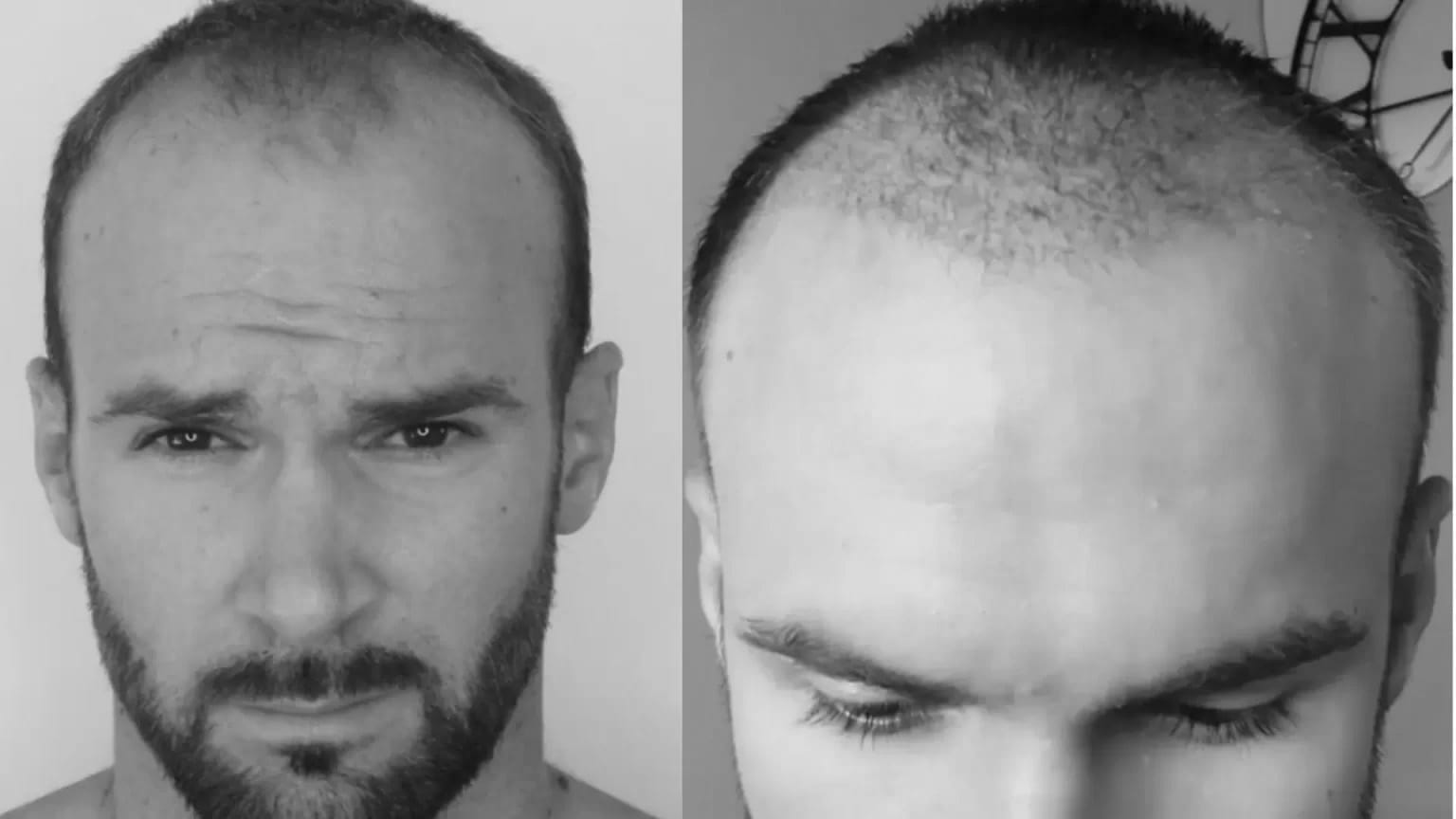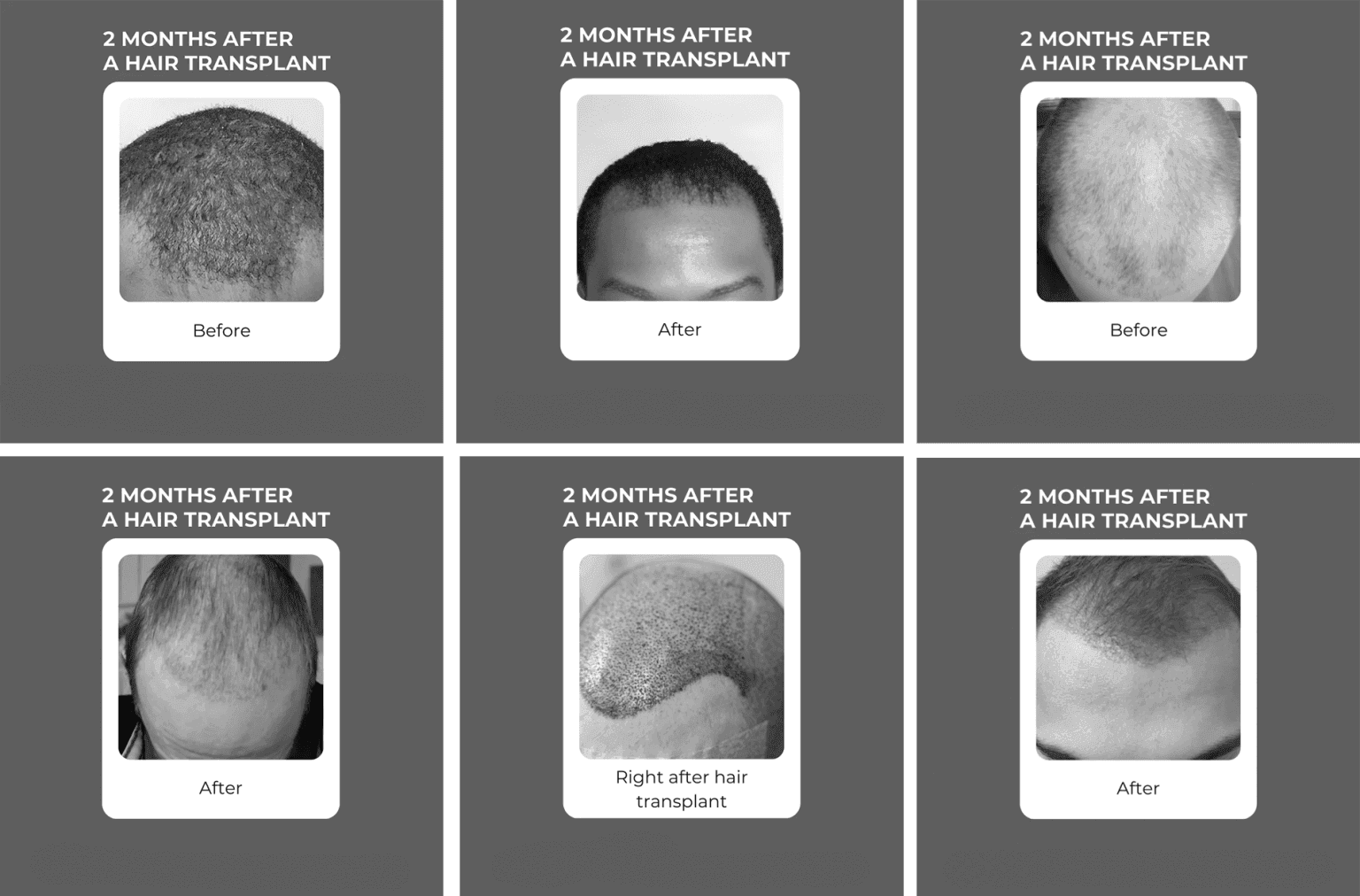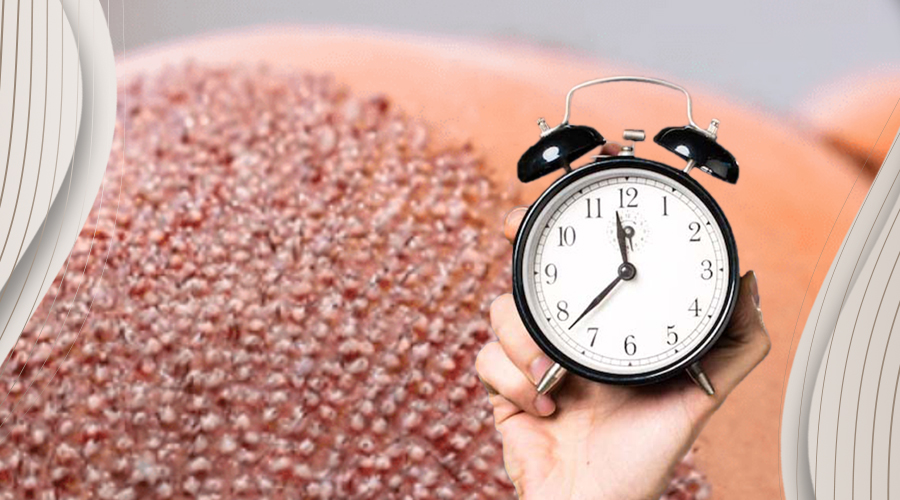2 Months After Hair Transplant
Congratulations on reaching the 2 month mark after your hair transplant! You may be asking, “What happens 2 months after hair transplant?” or “When will I see results after the surgery?” After your hair transplant procedure, it’s normal to experience shedding or an itchy scalp during this phase and don’t worry, these are part of the healing process.
If you’re not seeing much growth or have questions about what to expect 2 months after hair transplant, this guide will help. We’ll also give you tips on how to take care of your new hair and before-and-after photos to track your progress. Looking at other patients’ photos can help set realistic expectations for hair growth at 2 months after hair transplant and give you reassurance and understanding of what’s to come.
2 Months Post-Transplant Phase

The 2 months after a hair transplant can be exciting and confusing 2 months after hair transplant. While the initial healing period is over, new hair may not have emerged yet. In fact, some patients may experience more hair shedding during this time. This is known as shock loss when transplanted hair follicles go into a temporary resting phase after surgery. At 2 months, most of the transplanted hair has shed due to shock loss, commonly referred to as the ‘ugly duckling’ phase. This hair shedding is part of the natural growth cycle as hair follicles go through different phases before new hair grows. Most patients will see the speed of hair growth and shedding start to vary at 2 months.
You may also notice small pimples on your scalp which are usually benign and will resolve on their own. While it can be disappointing to see fallen hairs 2 months after hair transplant, remember that this is part of the process. At 2 months, many patients enter the ‘ugly duckling’ phase where visible growth is minimal. In time, you’ll see healthy new hair grow back in its place.
Stay positive and remember patience is key in this journey 2 months after hair transplant.
What to Expect 2 Months After Your Hair Transplant

At 2 months after your hair transplant, here’s what to expect:* Hair Shedding: Transplanted hairs will continue to shed during this period 2 months after hair transplant. This is temporary and normal part of the healing process.
- Minimal Growth: At this stage, you may not see much to no visible growth 2 months after hair transplant. However, this phase is short and changes will follow soon.
- Redness or Irritation: Some patients may experience lingering redness or mild irritation in the transplanted area. This is subtle, normal part of healing and will subside over time.
At 2 months, the visual result of the hair transplant is still developing 2 months after hair transplant and minimal changes are normal. Final result and full satisfaction will be seen in several months so patience is key at this stage.
Shedding 2 Months Post-Hair Transplant
Hair shedding after a hair transplant 2 months after hair transplant may seem counterintuitive; however, this occurrence, known as shock loss (also referred to as shock hair loss) is part of the recovery process that most patients experience in the first few weeks.
Shock loss happens when the transplanted hair follicles go into a natural resting phase called the telogen phase and the hair shafts fall out. It’s important to understand that although the visible hairs may fall out, the underlying hair follicles are healthy and intact beneath the scalp and will start to grow new hair 2 months after hair transplant. Hair growth and shedding occur in different stages which can result to patchy or uneven appearance as different areas of the scalp recover at different rates.
This phase can be tough for patients as it may give the impression of regression in the recovery journey 2 months after hair transplant. In reality, this is part of the healing process and new hair growth is on the horizon as you move through the stages of recovery!
Shock Loss Facts:
- Duration: Shock loss usually lasts for several weeks. Patients can expect to see new hair growth within 3 to 4 months post-procedure.
- Causes: This shedding is a natural physiological response to the trauma of the operation. Once the scalp has healed after the operation, the hair follicles will go back to the active growth phase.
- Patient Variability: While shock loss is common, the extent can vary greatly from person to person. Recovery and results can differ from one patient to another. Some may see minimal shedding while others may experience more hair loss.
Understanding this process is key to managing expectations during the hair transplant recovery journey. Remember, you are moving towards fuller hair and patience is key.
2 Months Post-Hair Transplant pictures

At 2 months after your hair transplant 2 months after hair transplant, you are back to your daily activities. However, don’t forget to follow your hair care regimen as proper care of your scalp and hair is important for optimal transplant results and long term success. In particular, caring for the transplanted hair grafts is crucial to support their integration and healthy growth. By this stage, the follicles are already firmly in their new homes post-transplant. Attending scheduled follow-up appointments at the clinic allows professionals to monitor your healing, check for redness and track your overall recovery progress.
Also, don’t forget to pay attention to the donor area as this is where the healthy hair follicles used in the transplant are and proper recovery of this area is key to achieving optimal results and better hair density 2 months after hair transplant.
2 Months Post-Transplant Care Checklist:
- Gentle Hair Washing
Continue using a gentle, sulfate-free shampoo 2 months after hair transplant. When washing, gently massage your scalp to promote blood circulation without irritating the transplanted grafts. - Moisturizing Your Scalp
Some patients may experience dryness or itchiness during this period 2 months after hair transplant. Applying a gentle moisturizer can help alleviate these symptoms without clogging the hair follicles. - Avoid Harsh Treatments
Avoid hair dyes, chemical treatments and heat styling tools (flat irons or blow dryers) 2 months after hair transplant as these can harm the newly transplanted hairs. - Sun Protection
Your scalp is still sensitive 2 months after hair transplant so if you will be outdoors, wear a hat or apply sunscreen specifically formulated for the scalp to protect against UV damage. - Healthy Lifestyle
Hair growth is linked to overall health 2 months after hair transplant. A balanced diet rich in essential vitamins (biotin, vitamin D, iron) will support the growth process. Staying hydrated and living a healthy lifestyle will also boost your hair recovery. For more pre and post hair transplant guidelines, check this out. - PRP (platelet-rich plasma) treatments
If recommended by your doctor 2 months after hair transplant, you may consider PRP sessions to speed up recovery and promote hair growth after the transplant.
By following these guidelines 2 months after hair transplant, you can improve your hair transplant results and healthy hair growth in the coming months.
Donor Area: Healing and What to Look For
The donor area is the foundation of your hair transplant journey, it plays a big role in the overall success of your hair restoration procedure. After hair transplant surgery, the healing process in the donor area is just as important as the recovery in the transplanted areas. Understanding what to expect and how to care for this area will help you achieve optimal new hair growth and smooth recovery.
Early Healing Signs
In the first few weeks after your hair transplantation, it’s normal to see some swelling, redness or mild itching in the donor area. These are normal signs that your scalp is healing and will subside as the days go by. You may also see some scabbing or crusting – this is part of the healing process and usually falls off within 7-10 days. During this stage, avoid scratching or rubbing the area as this can disrupt the healing hair follicles and affect your results. Swelling may occur after a hair transplant especially around the forehead and eyes but this will resolve within a few days as the healing process continues.
Aftercare Instructions
Your hair transplant doctor will give you detailed aftercare instructions specific to your procedure. Follow these guidelines to protect the newly transplanted hairs and support new hair growth. Keep the donor area clean and dry, use gentle hair care products and avoid harsh treatments will all contribute to healthy recovery.
Progress in the Next Months
As you enter the 2nd and 3rd month after your hair transplant, you’ll start to see the donor area looking more like your normal scalp. The initial scarring will start to fade and you may even see the first signs of new hairs emerging from the donor area – a good sign that your hair follicles are entering the growth phase.
Complications to Watch Out For
While most patients have a smooth recovery, it’s important to monitor the donor area for any unusual signs. Watch for redness, swelling, pain or discharge as these could be signs of infection or complication. If you notice anything unusual, contact your hair transplant doctor immediately.
Shock Loss in the Donor Area
Some shock loss can also occur in the donor area just like in the transplanted areas. This happens when hair follicles go into resting phase and some hairs fall out. This is a normal part of the hair transplant recovery process and should not be a cause for alarm – new hair growth will follow as your scalp heals.
Be patient during this stage of your hair transplant journey. The donor area will continue to improve in the next few months and with proper care, you’ll set the stage for healthy hair growth. Trust the process, follow your doctor’s aftercare instructions and know that each stage brings you closer to your hair transplant results.
2 Months Post-Hair Transplant: Hair Growth
Understanding the hair growth timeline is important to set realistic expectations after a hair transplant. It’s normal to expect immediate results 2 months after hair transplant but hair growth is a gradual process. At 2 months post hair transplant, many patients may not see significant growth which can be frustrating.
The number of grafts transplanted can affect the speed and density of new hair growth in the months after the procedure 2 months after hair transplant. Individual growth rates can also vary so some patients may see changes sooner or later than others.Remember that initial hair growth usually starts between 3-6 months post-transplant 2 months after hair transplant and full results can take up to 12 months or more. Hair grows in different phases – anagen (growth), catagen (transitional), and telogen (resting) which all affect the timing and appearance of new hair. After initial regrowth, hair will continue to mature and thicken over the next few months.
What to Expect in the Next Few Months:
- 3-6 Months: By 3 months 2 months after hair transplant, you can start to see early signs of new hair growth as new hairs emerge and become visible. Initially these hairs may be thin and fine but will thicken over time.
- 6-9 Months: By 6 months 2 months after hair transplant, noticeable growth should be apparent and hair texture and density will improve. During these months after hair transplant, changes will become more visible.
- 12 Months: At 12 months 2 months after hair transplant, most patients will have achieved full results of their hair transplant although some may still see improvements up to 18 months. These later months after hair transplant often bring final refinements.
Emotional Recovery
The emotional journey of a hair transplant 2 months after hair transplant is often overlooked but is just as important as the physical recovery. At 2 months post-transplant, many patients may feel anxious or frustrated due to lack of immediate results and temporary shock loss. At 2 months post-transplant, many patients find having a support network to cope with emotional challenges helpful. It’s normal to feel emotional fluctuations during this time. But as visible results start to appear, many patients notice a boost in confidence which can greatly enhance self-esteem and overall outlook.
Tips to Manage Emotional Ups and Downs:
- Be Patient: Acknowledge that hair growth is a slow process and shedding phase is temporary 2 months after hair transplant.
- Stay Informed: If you’re feeling unsure 2 months after hair transplant, don’t hesitate to reach out to your doctor or hair transplant specialist. Professional reassurance can be very comforting.
- Celebrate Small Wins: While major growth may not be visible yet 2 months after hair transplant, take time to recognize and celebrate small improvements along the way.### Maximizing Results
To get the best results from your hair transplant 2 months after hair transplant you need to take care and attention. While the growth process can’t be hastened, there are proactive steps you can take to improve the health and thickness of your new hair. In addition to these measures, other procedures such as PRP or other treatments may be considered to support hair growth.
In some cases grafts may be taken from other parts of the body 2 months after hair transplant, such as the back of the head or other areas so it’s important to take care of these donor areas to ensure overall success.
As your transplanted hair grows and reaches a suitable length and maturity, you may need to get a haircut to style and maintain the look of your new hair.
Tips to Support Hair Growth:
- Follow Surgeon’s Instructions: Follow all post-operative instructions given by your surgeon 2 months after hair transplant, including avoiding certain activities or products that can harm the grafts.
- Focus on Nutrition: A diet rich in protein, vitamins and minerals is essential for optimal hair growth 2 months after hair transplant. Consider supplements like biotin or zinc but only if recommended by your doctor.
- Be Consistent: Whether it’s gentle hair washing or avoiding harsh chemicals 2 months after hair transplant, consistency in your hair care routine is key to long term success.
By following these guidelines and managing physical and emotional aspects of recovery 2 months after hair transplant you can get the best out of your hair transplant.
Your Hair Growth Journey Continues
Reaching 2 months after hair transplant 2 months after hair transplant is a big milestone. Although you may not see the results you want yet, remember that patience is key. The growth process is gradual and your new hairline will become more defined as growth progresses. The best is yet to come.
During this waiting period 2 months after hair transplant focus on taking care of your scalp, stay positive and follow your doctor’s advice. If you had an FUE hair transplant you can expect a predictable timeline for visible results as the transplanted hair grows. By doing so you will set the stage for a successful hair growth experience.
FAQs
Is it normal to still have redness 2 months after hair transplant?
Yes, mild redness in the recipient area can persist for several months 2 months after hair transplant depending on your skin type. Most redness subsides after the second week but some lingering redness can remain. By 2 months, lingering redness in the recipient area should fade and the donor area should be fully healed. If you experience significant discomfort or irritation, consult your doctor.
I’m losing more hair—what should I do 2 months after hair transplant?
Hair shedding or shock loss 2 months after hair transplant is normal. This is temporary and new hair growth should start soon.
When will I see new hair growth 2 months after hair transplant?
According to the recovery timeline, most patients start to see new hair growth around 3 to 4 months post-transplant 2 months after hair transplant. Full results may take 12 to 18 months to manifest as hair grows and matures.
What is the success rate of hair transplant 2 months after hair transplant?
The success rate of hair transplant is around 95%. This can vary depending on the skill of the surgeon, quality of donor hair and how well the patient follows post-operative care instructions 2 months after hair transplant. Choosing an experienced specialist and proper care is key to getting the best results.
Useful Links
- Shock Loss after Hair Transplant
- Book a free consultation to discuss your goals, hair condition and learn more about the hair transplant process.

